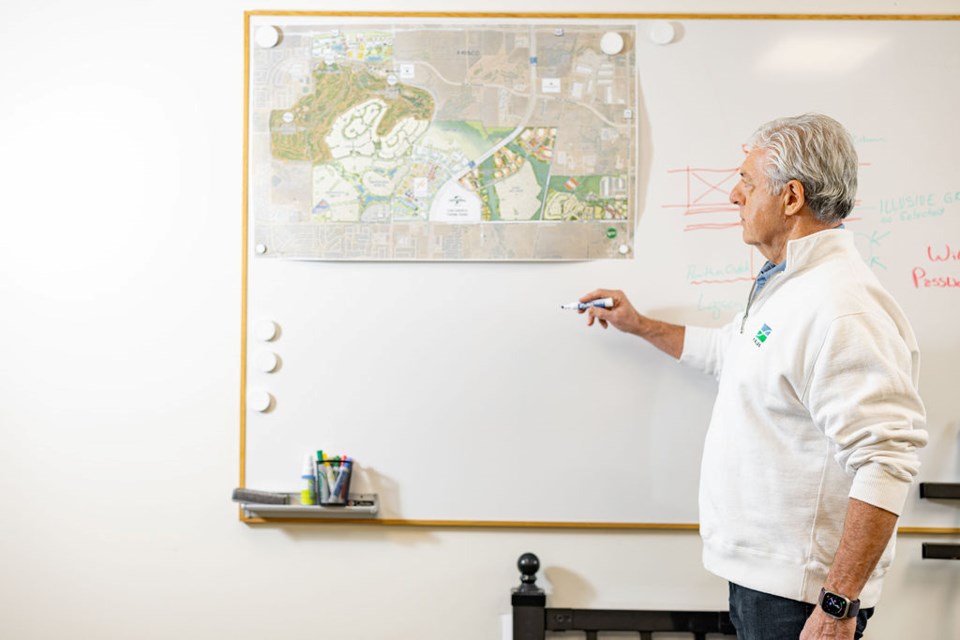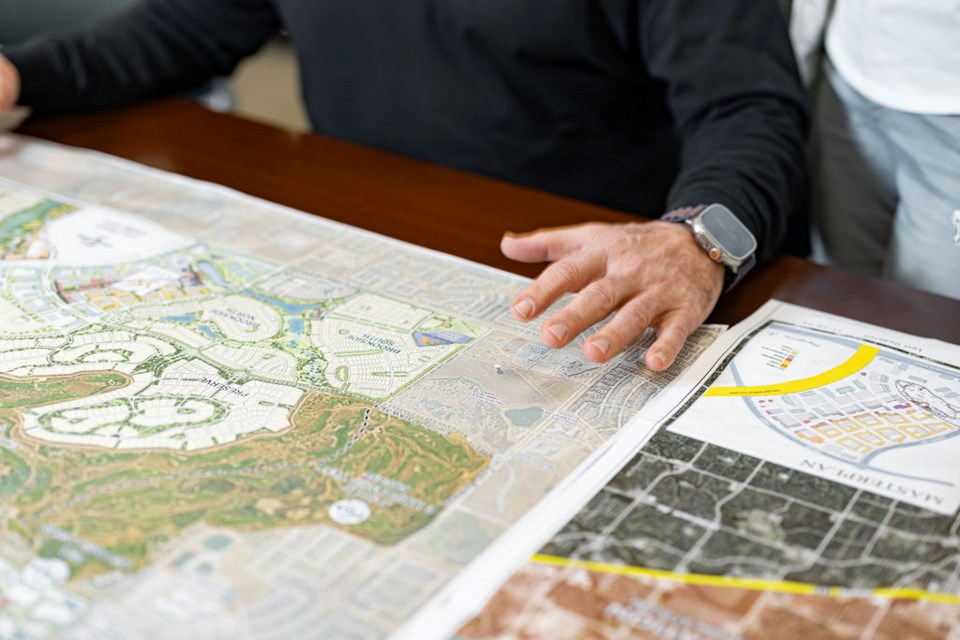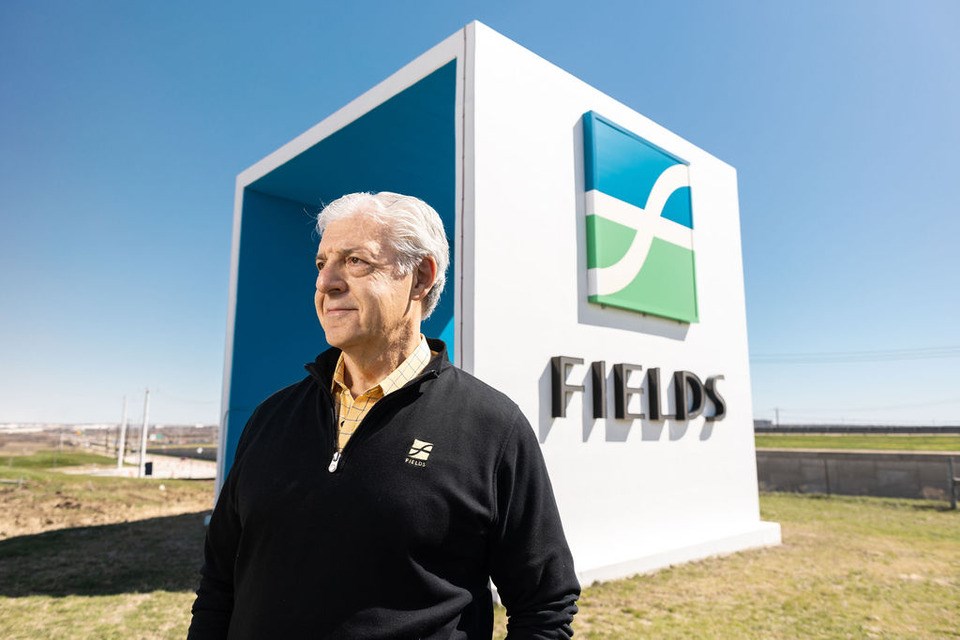“The destination does not exist,” my driver says. Sounds about right. I explain that I’m going to a construction site. As we drive, I see only dirt, grass and acres of opportunity — the future epicenter of Frisco and, most likely, Collin County.
It’s a strange feeling to know that this ranchland will soon be a bustling community: home to over 14,500 single- and multi-family homes, 54 acres of retail and apartments, and one million square feet of office space — a $10 billion project. Today, this sparse terrain is best known for the relocated PGA headquarters, or perhaps the future home of a new Universal Kids Resort.
With no clear indication of where to go amid road barriers and construction equipment, my driver awkwardly drops me off on the corner of Legacy Drive and Panther Creek Parkway in Frisco. Crossing the dusty lot over rocks, shrubs and dirt, I make my way to a nondescript trailer, identifiable only by a small sign, reading simply, “Fields.”
Entering the trailer, I’m greeted by … no one. It’s empty, save for a long counter that I assume serves as a desk, storage and, for the moment, the reception area. The double doors are cracked a smidge. I catch the eye of Fehmi Karahan, who is hard at work building and planning. It won’t be his first time either: he’s already changed Collin County forever. Twice.
It’s been a few years since we last sat down together, before COVID. We’ve all gotten a little older. Karahan, seemingly less so. I remember meeting him less than a year before the opening of Legacy West. We met at Bistro 31 down in Highland Park Village, introduced by a mutual friend, restaurateur Alberto Lombardi. Immediately, I was impressed.

Karahan is the master developer behind The Shops at Legacy and Legacy West in Plano. For now, he’s turned his skills to Frisco with Fields. “The one thing that we need to differentiate when we say project is that there are two projects right now,” he says. The Fields master plan is 2,545 acres of land — the equivalent of 1,928 football fields — that, Karahan explains, will be transformed into “a city within a city.” He has maps and blueprints out on the table that show homes, offices, shops and restaurants. “Then, in the heart of that, we have Fields West,” he says, pointing to the 54-acre, $2 billion mixed-use development that will be at the center of it all.
“People, often, they say, ‘How do you differentiate Fields West from Legacy West?’” Karahan says. They do sound similar. The “West” in “Fields West” comes from its location and is a nod to the Legacy West branding, he explains. “I came up with the idea. There are two sisters: the older sister because she was built eight years ago, and then, this is the younger sister.” And, he continues, the younger sister can look to the older sister, see what she does well and even strive to do things better or, at least, slightly differently.
“I’m different — I see every little detail that others cannot see,” he says. “I’m known for attention to that in every little detail.”
“Six months ago, there weren’t any homes here,” says Karahan. “Now, they’re building faster than ever.” We’re in his black SUV, driving down Panther Creek. “Frisco remains one of the most desirable places to live,” he says. “It’s safe, and the parks and schools attract a lot of families. But there is not much undeveloped land left.”
Ten families have already moved into the Fields’ neighborhood Brookside. Construction hasn't started on the massive gated community dubbed The Preserve, which Karahan says will be “upscale on a Highland Park level.” And six months from now, of course, there will be even more homes.
It’s a lot to take in. This man is concurrently thinking on more levels than most of us are even aware exist while intensely focused on a single project. A singular vision. Empty land rolls by, but Karahan can visualize it all — just like Michelangelo visualized David in a block of Tuscan marble. “I see dirt,” he says. “And I see how that comes together.” The successful delivery of the extensive residential, retail, dining and entertainment components of a project of this scale requires the orchestration of many moving parts. Karahan has to bring together city officials, investors, land owners, financiers, construction companies, homebuilders, retailers, restaurateurs, lawyers, architects, realtors, homeowners, corporations, fire and safety, insurance, and water and power — to name just a few. He also needs to make sure that their goals are aligned conceptually, philosophically and economically.
As we drive, he points out feature after feature of what is coming, when and where. His attention to detail is astounding, including things most people would take for granted — trees, for example. He believes strongly that beautiful, mature trees make a big impact. When building Legacy West, he invested $2 million to relocate trees that had been on the property, take care of them while the project was being built, and then replant them. In Fields, he’s invested more: “There weren’t any trees here to salvage, so we committed to purchasing $10 million worth of trees. We will have very large-caliber trees everywhere, which will feel like these places have been existing for a long time.” Like I said, it’s a lot to take in. It’s a lot for Karahan, too.
“I literally cannot sleep more than maybe four or five hours because it just takes everything,” he says, adding that large-scale developments like this are complicated, even in places like Frisco that do everything possible to streamline the process. Even with the lack of sleep, Karahan doesn’t look tired. This is what he was meant to do. He’s always been building. “When I was growing up in Turkey, we didn’t have much,” he says. He didn’t have LEGO or Playmobil. “I loved building, so my dad would chop up some wood pieces.” And with those small pieces of wood, he would build castles, homes and palaces. He is doing the same now — but with bigger pieces of wood.
In total, there will be 14,500 homes within the Fields project. “We have homes for almost every price category,” Karahan says. “You have $600,000, $700,000, $800,000, and multimillion-dollar homes, but all with golf, entertainment and dining.” Plus, there will be over 25 miles of trails. “All of that makes these really attractive for companies.” A very big part of this project, after all, is the corporate clients and their employees and families — our future friends and neighbors.

Part of the formula is a generous amount of office space — 1 million square feet, to be exact — a big bet at a time when more people want to continue working remotely. Karahan is clear-eyed. “In the overall real estate market in the United States, office space is the worst category of real estate,” he says. “The vacancies are really high. Dallas has, I think, somewhere around 20% or more vacancy. In some cities, they even have higher percentages.” Companies still aren’t sure what they will do, or how much of their staff wants to return to a traditional work environment. Despite, perhaps, a tinge of concern, Karahan is optimistic: “I personally feel very positive about the future of Texas and North Texas.” Issues in New York or California, he believes, will continue to drive relocation to the Lone Star State, whether that’s Austin, Houston or Dallas. “As long as people keep moving to Texas, which is happening, I see office recouping.”
Karahan is right, of course. Office space is a terrible business at the moment. Yet it is a critical part of this project. Then again, there are still many companies that need people in the office, and Karahan is betting that a beautiful office alone is no longer enough. Instead, he’s offering hiking and nature, golf, shopping and dining. “Companies want to provide their employees something more than just salaries — they want to provide amenities and convenience. I feel that the Fields development does that.” This is no “build it and they will come” project, this is precision community engineering at its finest. Fields is a regional economic engine that will power our region for decades to come, driven by people and a powerful sense of community.
Karahan can see how it all comes together: Fields and Fields West with their unique features, including the headquarters of the PGA of America and its championship golf courses; luxury hotels, including a 5-star Ritz-Carlton; extensive miles of parks and even the unexpected addition of Universal Studios’ first kid-friendly theme park: Universal Kids Resort. The inclusion of these unique attractions sets Fields up to be so much more than a remarkable development and further attracts the talent that will drive the corporate relocation. As much as Fields is benefiting from being in Frisco, it is also set to enhance Frisco’s reputation as a center of prosperity, culture, innovation and economic impact.
“There’s a term, ‘fee developers,’” he says. “They go try to develop something and get a fee, and they can jump into a lot of things because they want to generate their fees. I’m not a fee developer. I invest in what I do. I give everything I have to one project at a time, but my projects are massive projects with cities involved.”
So if you are not a fee developer, I ask, what do you see yourself as?
“Maestro,” he says.
___
“When I was little, I guess 7-8 years or so, my dad in Turkey called me over to the kitchen,” Karahan says, making a right turn and passing the University of North Texas’ new Frisco campus. “My dad gives me this raw egg and tells me to drop it. The egg shatters on the counter. He says, ‘Now fix it.’” Karahan told his father that he couldn’t. “And so my dad says, ‘That is like my trust — once you break it, you can never fix it.’” A powerful lesson. Karahan continues, “So that’s about trustworthy relationships, anything in partnership, marriage, business partnerships, anything involving trust, I don’t believe in trust of 99%. If there is a fraction of a percent doubt, that’s not trust. I’m lucky because I build very trustworthy relations.”
Judging by the substantial faith that has been placed in Karahan with this project, he has clearly earned a high level of trust, which is entirely the point. He has been doing so since he came to America. “And that’s most important for someone like me, coming from Turkey, speaking with an accent and having no money to my name.” Karahan arrived in the U.S. in 1978 on a scholarship to Columbia University. He worked for $3 per hour handing out flyers in New York. Six months later, he came to Texas and finished his degree at the University of North Texas, and in 1980, he was offered a job by a fellow Turk who worked in real estate. In 1984, he started his own business. “I have achieved in-roads in an enormous amount of trust-based relations,” he says. “The foundation of all of these is trust.”
Trust builds reputations. And after that, opportunities appear. This is how he ended up working on Fields. It started with a phone call. Ray Hunt, the executive chairman of Hunt Consolidated Inc., and Chris Kleinert, the CEO of Hunt Realty, wanted to know what he thought of a piece of land in Frisco. It was, as Karahan describes it, “a doughnut hole” — a tract in the middle of one of the most rapidly growing places in the state, if not the country. Karahan told them that they should buy it, but that he would love to invest. “They said it was music to their ears,” he says. A deal like this does not happen based on a glossy brochure and a PowerPoint; an outstanding reputation and considerable amounts of trust are what make it all possible. These are things Karahan has cultivated in spades. There is a saying that I love about overnight successes, which I think applies here: they take years of hard work to make happen. And years of hard work are going into Fields.

“The gratification you get from being able to create these places where people are buying homes that they are proud of is very rewarding,” he says. “Who would not want to be involved in this kind of project — the scale and the size that creates that kind of environment? And do it with partners who trust you and give you the tools and financial commitments? And have the city leaders that get up and believe in you? It’s an incredible feeling.”
“You take 2,600 acres of land, and then, all of a sudden, there is all I had envisioned there. But who does it belong to? The people.”
That evening, I find myself at Legacy West, walking past Louis Vuitton and heading to Kai for dinner with friends, marveling at how established and polished it all feels. I remember standing there, less than a decade ago, with only a field of grass waving at me. How quickly and dramatically things can change — just like a movement in a symphony.
I think about what Karahan said — that his job was to be a maestro. I can see that. He’s bringing together engineers, architects, leasing people, banks, financiers, liquidity partners and city officials — everyone. Because this can’t be done without all those people together, working together in harmony.
Eds note: An earlier version of this article stated that families have already moved into The Preserve. It has since been updated.




